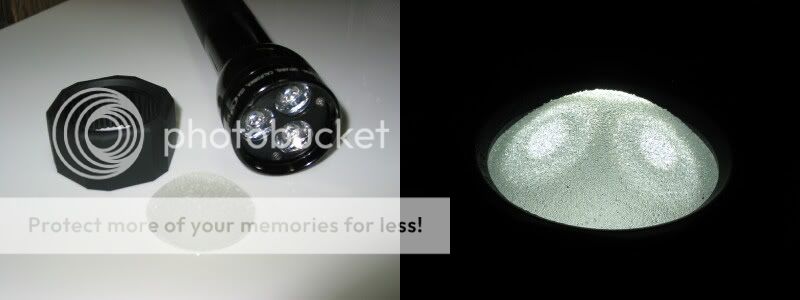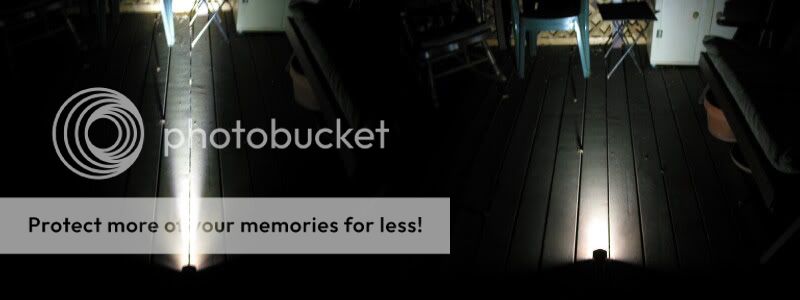mrmike
Newly Enlightened
High power lights are fun, but sometimes the hotspot is too much, and what you really need is all flood.
There are all sorts of ways to concoct diffusers, and I wanted to share this particular experiment of mine, which is a continuation of a previous project: http://www.candlepowerforums.com/vb/showthread.php?t=146478&page=9
Diffusers are great for killing off that glaring hot-spot, but most are translucent, and really cut down on the amount of transmitted light. I was looking for a better solution...
Some time ago I worked for an art supply company, and we sold 3M Scotchlite "Retro-reflective Glass Beads". They are used by sign painters to catch/reflect light; to really make their signs stand out (especially for fancy jobs like firetrucks and ambulances). You see the same beads used on highway signs, and the reflective material on running shoes.
The Scotchlite beads are painfully expensive, but you can get them much cheaper from industrial supply catalogs or some arts/craft stores.
In this case, instead of using it as a reflector (to catch your headlights for example), I'm using it as a diffuser. I took a 50mm Aspheric Lens, mixed up some 5-minute epoxy, brushed it on the curved part of the lens (I used masking tape on the flat side for neatness), and dumped the glass beads on top of the lens. I poured it on until it was entirely covered in a mound of beads, and let it set a few hours.
The Light is a 4-D Mag, with a Terralux TLE-300M. I used a cheap ($5) Surplus Shed 50mm Aspheric (why use an expensive coated lens when I'm going to cover it with epoxy and glass?). The battery in it is a stick of Elite 4500s. The six cell stick usually tops off around 8.4 volts, so when used in a previous ROP project it habitually fried the bulbs. It works beautifully with the TLE-300M.
There's a UCL lens mounted in the head. When I want to use the diffuser, I just set it on top of the UCL lens/head, and hold it in place with the anti-roll widget. It works almost too well.

UCL Lens, no Aspheric-Diffuser (far and zoom)

With Aspheric-Diffuser

No diffuser (left).......... With diffuser (right)


Ceiling Bounce, no diffuser (left).......... With diffuser (right)
Wow, flashlights really make the ceiling look disgustingly dirty... such are the joys of forced air heat

I'm trying to get a better picture of the material so you can see what it looks like. This is looking at the flat/plano side of the lens, illuminated from behind by a Fenix E01 propped up on my NDI.

And here's a view from the front/convex side, once again illuminated by the Fenix E01 instead of the Terralux, to avoid killing the image with glare.

I think it works very well. Obviously you could do this with a Malkoff, or any flashlight. The Mag anti-roll rubber gadget makes it easy to add/remove such a lens to any C-cell/D-cell Maglite.

Is the coating tough? It's epoxy and glass, so although it looks fragile, it certainly is not.
There are all sorts of ways to concoct diffusers, and I wanted to share this particular experiment of mine, which is a continuation of a previous project: http://www.candlepowerforums.com/vb/showthread.php?t=146478&page=9
Diffusers are great for killing off that glaring hot-spot, but most are translucent, and really cut down on the amount of transmitted light. I was looking for a better solution...
Some time ago I worked for an art supply company, and we sold 3M Scotchlite "Retro-reflective Glass Beads". They are used by sign painters to catch/reflect light; to really make their signs stand out (especially for fancy jobs like firetrucks and ambulances). You see the same beads used on highway signs, and the reflective material on running shoes.
The Scotchlite beads are painfully expensive, but you can get them much cheaper from industrial supply catalogs or some arts/craft stores.
In this case, instead of using it as a reflector (to catch your headlights for example), I'm using it as a diffuser. I took a 50mm Aspheric Lens, mixed up some 5-minute epoxy, brushed it on the curved part of the lens (I used masking tape on the flat side for neatness), and dumped the glass beads on top of the lens. I poured it on until it was entirely covered in a mound of beads, and let it set a few hours.
The Light is a 4-D Mag, with a Terralux TLE-300M. I used a cheap ($5) Surplus Shed 50mm Aspheric (why use an expensive coated lens when I'm going to cover it with epoxy and glass?). The battery in it is a stick of Elite 4500s. The six cell stick usually tops off around 8.4 volts, so when used in a previous ROP project it habitually fried the bulbs. It works beautifully with the TLE-300M.
There's a UCL lens mounted in the head. When I want to use the diffuser, I just set it on top of the UCL lens/head, and hold it in place with the anti-roll widget. It works almost too well.

UCL Lens, no Aspheric-Diffuser (far and zoom)

With Aspheric-Diffuser

No diffuser (left).......... With diffuser (right)


Ceiling Bounce, no diffuser (left).......... With diffuser (right)
Wow, flashlights really make the ceiling look disgustingly dirty... such are the joys of forced air heat

I'm trying to get a better picture of the material so you can see what it looks like. This is looking at the flat/plano side of the lens, illuminated from behind by a Fenix E01 propped up on my NDI.

And here's a view from the front/convex side, once again illuminated by the Fenix E01 instead of the Terralux, to avoid killing the image with glare.

I think it works very well. Obviously you could do this with a Malkoff, or any flashlight. The Mag anti-roll rubber gadget makes it easy to add/remove such a lens to any C-cell/D-cell Maglite.

Is the coating tough? It's epoxy and glass, so although it looks fragile, it certainly is not.


